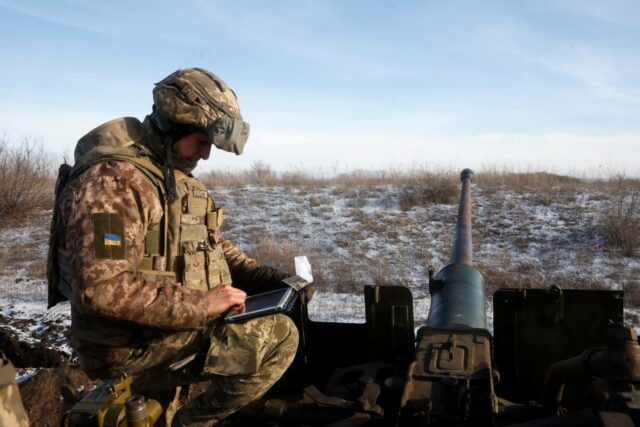
New Russian Offensive Underway in Ukraine
Publication: Eurasia Daily Monitor Volume: 20 Issue: 28
By:

If at the end of 2022 it was assumed that Ukraine would be the first to attack to gain the initiative on the battlefield, more recent calculations have posited that the Russians will strike first and appear to be gearing up for their next massive offensive, though the Ukrainian Armed Forces stand ready to repel such maneuvers (Meduza, January 4). Indeed, the anticipated Russian offensive seems to already be underway (Euractiv, February 14).
A number of reasons underline the change in this calculus. To begin with, Ukrainian forces are bogged down in Bakhmut, which has created political obstacles to abandoning the city by imposing the image of the city as a fortress (The Moscow Times, January 3). Initially, it made sense to keep Bakhmut until the loss of Soledar. Then, it made sense to keep Bakhmut until the Russians occupied the suburban heights in the eastern part of the city. Now, the sooner the Ukrainians withdraw from the city the better, as the Russian side is starting an offensive in the direction of Chasiv Yar, the only location connecting Bakhmut with “mainland” Ukraine. Kyiv’s Western allies have also debated this threat, with some concluding that it is better for Ukrainian forces to leave Bakhmut and regroup (Radio Free Europe/Radio Liberty, February 3)
Overall, fighting for the next month or so will most likely be the most intense since May of last year. Due to this expectation, in parallel with the organization of strike formations, of which many are planned, eight brigades of the Ukrainian National Guard have already been formed, and more brigades are to come—about 30 in total (YouTube, February 6).
Furthermore, along with the rotation and replenishment of already existing brigades, new Ukrainian corps are being formed, and soldiers are being sent for training in North Atlantic Treaty Organization member countries. For its part, the European Union has already announced that it is increasing its training mission from 15,000 to 30,000, including training at the battalion and brigade levels (Dw.com/ru, February 1).
This is all superimposed on the dual problems of impending shortages of critical munitions and a lack of government funds. It has come to the point that a number of Ukrainian units are suffering a shortage of anti-tank weapons, which forces them to stand against tanks with small arms (Author’s interview with a mechanized brigade officer, January 30)
The anticipated heavy fighting will become a hefty burden for Ukraine’s infantry. Russia is actively repositioning and reinforcing its forces along the frontlines for the offensive. This, in turn, is pushing Ukraine to disperse its forces along the front, as Russian forces have increased shelling fortifications in key front-line areas. For example, the Russian side has been incessantly shelling Chernihiv region from the territory of Bryansk region, on which many fortifications were erected, including ditches, trenches and minefields (T.me/er_molina, February 3). Schools and municipal institutions are also preparing to accommodate soldiers (Istories.media, January 27). Such actions force the Ukrainian command to react and pull out on the potential direction of forces and means.
For the current offensive, Russia is most likely considering several options. One would be the second battle for Kharkiv. Geographically, this is quite significant as the one who controls Kharkiv and the surrounding region effectively controls Donbas. This scenario is also spurred on by the fact that the Russians are already trying to conduct reconnaissance with combat and tactical sorties in the area. In December 2022, near Ternova, Russian forces attempted an attack but were met with stiff resistance. In late January 2023, the Russians again tried to “probe” Ukraine’s defenses in this direction, hoping to arrange a small breakthrough, but they were once again stopped and forced to return to their original positions (T.me/romanov_92, January 29).
Commander of the Russian forces in Ukraine General Valery Gerasimov will most likely focus on carrying out the assigned task of reaching the borders of the Luhansk and Donetsk regions. This could take place both with the aforementioned offensive through Kharkiv and with the continuation of Russia’s creeping offensive in Donbas. So far, for the most part, Ukrainian forces have been successful in stopping breakthroughs in other directions, including Vuhledar and Vodyane (Kmu.gov.ua, February 11; Ukrainska Pravda, February 14). In the Vuhledar region, the defeated Russian forces were made up of units from Russia’s Pacific Fleet, highlighting the ongoing manpower shortages plaguing the Russian military (T.me/DeepStateUA, February 9).
Based on these developments, one can conclude that the Russian offensive will likely be precise in nature with the concentration of forces, avoiding an offensive on a broad front. For example, Moscow concentrated its forces and efforts on Soledar and eventually took it. Using a similar strategy, Russian units will try to storm Chasiv Yar, grinding it into a state of ruins, as has been done in Bakhmut and Maryinka. This approach may underline that the Kremlin believes a protracted war would, in fact, be in its favor (see EDM, February 6). The concentration of Russian forces is currently moving in five primary directions: Vuhledar, Avdeevka, Bakhmut, Kreminna and Kupyansk. So far, the Ukrainian Armed Forces have managed to hold back the Russian onslaught, as evidenced by footage from the battlefield (T.me/TyskNIP, February 9).
But various problems and deficits within the Ukrainian army might allow the Russian side to take advantage of this window of opportunity. Whether this newly launched offensive will be successful largely depends on Ukraine’s posturing of it defense forces as well as the speed with which Ukraine’s allies can provide Kyiv with desperately needed munitions. Nevertheless, the fact that the next couple months of fighting will be difficult is unequivocal, but after March, a completely different “game” will begin on the Ukrainian battlefield when Western armor arrives bolstering Ukraine’s military capabilities.



